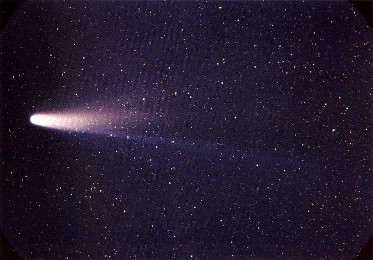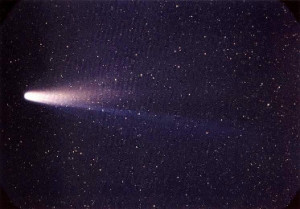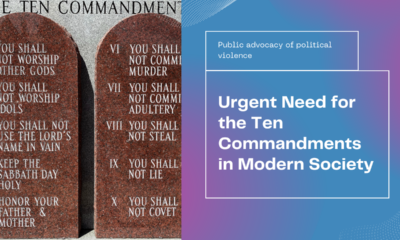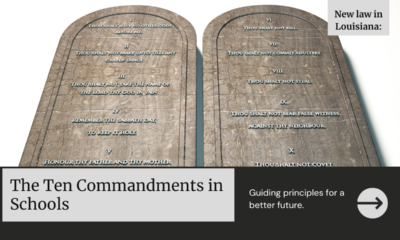Creation Corner
Global flood astronomical fix revised

Dr. Walt Brown, Director of the Center for Scientific Creation, recently announced a new figure for his astronomical fix for the Global Flood. Like his earlier fix, he based this one on a common close-approach date for comets. But the new fix uses true orbital periods, not the hypothetical periods in the cometary catalog.
New date for the global flood
The new date for the Global Flood is 3290 BC, give or take seven years. This is fifty-four years more recent than his first figure of 3344.5 BC (give or take one).
Brown explained the change, and the new evidence, to this correspondent by telephone yesterday. Before, he selected the five comets, with at least three recorded apparitions, having the longest periods listed in the 2008 Catalogue of Cometary Orbits. But he realized that the Cometary Catalogue publishes hypothetical periods that would never hold for a real orbit.
Any comet, or any other object, is always in an orbit it might follow, if no other body had any influence on it except for being part of the hypothetical “primary point mass.” (That mass includes the actual primary and any other body in orbit around it, that lies inside the object in question.) Astronomers call this orbit the osculating orbit, or literally the kissing orbit because it kisses the true path.
But of course, no object ever follows the osculating orbit. The real orbit is the path it follows. And that path will never be a perfect ellipse.
For a planet (or dwarf planet), the difference is barely enough to consider. Not so for a comet. And: the osculating orbit can never be constant. It changes with every second, because other objects always change its course. So the period of a comet (time to make its closest approach, or perihelion, from one orbit to the next) is never the same.
This does not mean no one can ever calculate the true period. The problem: the Cometary Catalogue publishes the period of the osculating orbit. Because those orbits are never real, using them to project a comet’s course forward or backward in time will always introduce an error.
Two clock-like comets
Page 157 of the Catalogue has a long list of comets with fairly long periods. Of these, two have periods that change the least: Comet 1P/Halley and Comet 109P/Swift-Tuttle:
| Comet | Earliest known perihelion | Perihelion Distance | Inclination | Earliest known period | Expected error in predicting launch date, as σ√N |
| Halley | 1403.80 BC | 0.586 AU | 162.3° | 69.86 years | 8.14 years |
| Swift-Tuttle | 702.30 BC | 0.9595 AU | 113.45° | 129.33 years | 13.31 years |
Both are retrograde. And earlier investigators have projected each one hundreds of years before Christ. See Yeomans and Kiang, 1981, and Yau, Yeomans and Weissman, 1994. According to those sources, those two comets changed their periods not more than three years for Halley and five for Swift-Tuttle. The calculated changes yield expected errors of 8.14 and 13.31 years for the two comets.
Brown shared with this correspondent a spreadsheet showing how the two comets’ periods changed since their earliest calculated apparition. Swift-Tuttle shows a larger error for two reasons: fewer apparitions (because the periods are longer), and greater changes. Even so, Yeomans (see above) said Swift-Tuttle’s period changes were smaller than his team expected.
Even with only two qualified comets, Brown says the case for cometary convergence is “stronger than ever.” He assigns ninety-eight percent confidence to it.
What this means
The new figure validates the Septuagint (LXX), and specifically the Codex Alexandrinus, as the most likely text for the ages of the patriarchs in the eleven generations after the Global Flood.
This correspondent calculated twenty-four possible dates for the Global Flood, based on alternative theories for:
- The chronology of the Kings of Israel and Judah following Solomon’s reign,
- The chronology of the Sojourn in Egypt,
- The chronology of the life of Terah, father of Abraham, and
- The use of three different manuscript sources of the ages of the Patriarchs.
The closest match to 3290 BC is 3283 BC. That date assumes:
- A long chronology for the Hebrew kings (and hence a longer chronology for the Assyrian Empire, using about fifty missing years according to Martin Anstey),
- A long chronology for the Sojourn in Egypt,
- An early birth date for Abraham (when Terah was 70 years old, not 130), and
- The LXX as the best manuscript source.
Note: the 3290 BC date could also be consistent with a calculated date of 3293 BC. That date assumes a late birth of Abraham, and that Nahor the Elder (Terah’s father, as distinct from Terah’s other son) was twenty-nine years old when Terah was born – not seventy-nine as the LXX says. The two ages for Nahor the Elder at the birth of his son are fifty years apart between the LXX and the Masoretic Text – an extraordinary number, since in every other disputed case, the ages are 100 years apart. This correspondent plans further research on this point.
The Hydroplate Theory of the Global Flood predicts that all comets, if one could adequately calculate their true periods to a year approaching the fourth millennium BC, would seem to have perihelia in the same year. In that year, the theory says, the Global Flood event launched one percent of the total mass of the earth into space, as water, rock and mud. Some of this water, once beyond earth’s gravity, accreted to form the comets. Thus 3290 BC (or seven years earlier or later) is the most likely launch date.
Brown also feels the Patriarchal ages, in all manuscripts of Genesis chapter 11, might have rounding error. This error might mean the calculated date is off by twelve years. But this would not apply to the length of the Sojourn in Egypt, the interval between the Exodus and the groundbreaking of the Temple (I Kings 6:1-2), or the interlocking chronologies of the Kings of Israel and Judah.
[subscribe2]
Terry A. Hurlbut has been a student of politics, philosophy, and science for more than 35 years. He is a graduate of Yale College and has served as a physician-level laboratory administrator in a 250-bed community hospital. He also is a serious student of the Bible, is conversant in its two primary original languages, and has followed the creation-science movement closely since 1993.
-

 Executive4 days ago
Executive4 days agoSecret Service chief gets no solace
-

 Executive3 days ago
Executive3 days agoWaste of the Day: Louisville Taxpayers Pay Nearly $600,000 For Empty Building’s Maintenance, Security
-

 Guest Columns4 days ago
Guest Columns4 days agoFear Itself: Democrats’ Favorite Strategy Caused Their Current Chaos
-

 Executive3 days ago
Executive3 days agoWhere is Joe Biden – or Jill?
-

 Executive1 day ago
Executive1 day agoWaste of the Day: Throwback Thursday: Cities Used Crime Prevention Funds on Soccer Games, Paper Shredding
-

 Executive2 days ago
Executive2 days agoFacile and politically motivated suggestions
-

 Civilization4 days ago
Civilization4 days agoBuild Iron Dome in the United States To Prepare for Israel’s Worst Day
-

 Executive4 days ago
Executive4 days agoThe Emerging GOP Plan To Beat Kamala Harris
















Michael Alan Kline Sr liked this on Facebook.
This is a clever approach, but I think it misses the mark by a few millennia.
Side note: First paragraph starts with an error. “The new date for the Global Flood is 3290 BC, give or take seven years. This is fifty-four years earlier than his first figure of 3344.5 BC (give or take one).” I think 3290 BC is about 54 years “later” (not earlier) than 3344.5 BC. Years count down in BC (not up).
The problem with being too literal about the Bible, is that you miss the spirit of it. And there’s a whole lot there that people are missing because of this.
“Who also hath made us able ministers of the new testament; not of the letter, but of the spirit: for the letter killeth, but the spirit giveth life” (2 Corinthians 3:6 KJV).
The fact that there are different versions of scripture should give us pause (humility).
What does Genesis 5:2 mean? Adam is “them” and both male and female. How does this fact (Adam as “tribe”) relate to the other early patriarchs?
We can thumb our noses at reality (science) and work at being deluded, or we can take these things into consideration and find a more divine answer. God created reality — that which science studies. The fact that we have this Internet shows that scientists are doing a whole lot right when it comes to understanding reality. They’re not perfect, but so are a whole lot of believers who have their own special interpretation of scripture — so much disagreement about the Good Book.
Any honest discussion of these vital topics needs to be open to more than the literal. Literal is what scientists practice. Where God, spirit and creation are involved, there is far more than literal.
Take for instance the immediate death of Adam and Eve when they took the forbidden fruit. They did not literally, physically die as would seem to be implied by God’s proclamation. Instead, both were escorted out of the Garden and Adam lived up to 930 “years.”
But there are passages in the Bible which tell us that years are not years. In fact, Genesis 5 tells us repeatedly that “days” are “years,” and that these are the “generations” of Adam.
One fellow Christian of the late 19th and early 20th century told us that Noah’s Flood happened about 28,000 BC and that one of the earliest meetings of humanity occurred about 10.5 million BC. I found these in Genesis and it’s relatively simple, too.
What is startling about this discovery is that the Flood date gives us the identity of the Daughters of Men! And, perhaps even more critically, it tells us why the Flood was necessary — to prevent a very specific type of wickedness and violence from ever happening again. All of the garden-variety wickedness and violence that humans have done since the Flood are nothing compared to the type which occurred before the Flood.
A book documenting the details is currently in progress:
link to genesiscode.net
This shows how Noah’s Flood was in every way an act of love.
“those two comets changed their periods not more than three years for Halley and five for Swift-Tuttle.”
From one period to the next, you mean; not overall. The longest observed period of Halley was 11.57 years longer than the shortest observed period; for Swift-Tuttle the difference was similarly 11.49 years.
For any perihelion, there are at least three choices of period that you could pick to perform the stepback: the osculating period at the point of perihelion, which you describe as ‘never real’; the preceding historical period (length of time between the selected perihelion and the previous one); or the following historical period (length of time between the selected perihelion and the subsequent perihelion).
If he is stepping back from 1404 BC to 3290 BC using a period that is not the osculating period, he must be using the historical period for the 1404 BC-1334 BC orbit. OK. So we should be able to step back to 3290 BC from the 1334 BC perihelion using the 1334-1266 BC historical period, which is 1.83 years _shorter_, and the final analysis should be pretty much unchanged, right? After all, Dr. Brown’s sigma(sqrt(N)) figure would suggest that the predicted perihelia errors would only be different by (1.56*sqrt28)-(1.56*sqrt27), or 54 days.
But if we step back 27 periods from 1404 BC and 28 periods from 1334 BC using the following historical periods, we get perihelion predictions of Aug 11, 3290 BC with 1 sigma error of 8.10 years vs. Oct 24 3239 BC with 1 sigma error of 8.25 years. That’s a 51 year difference in the predicted perihelia. Do they both have a 99.7% chance of being within the true perihelion by 3 sigma? Nope.
It is easily shown that Dr. Brown’s method does not predict known historical perihelia based on more recent perihelia and their associated periods; at least not with the degree of error that he claims. This is true for stepbacks of less than ten periods, and the problem only gets worse as you increase the number of stepbacks. In practice, the errors approach and even exceed an entire cometary period! If the technique at the core of this analysis is fundamentally unsound, why should any of the conclusions drawn from the analysis be taken seriously?
[…] Drs. Brown and Jachimstahl. (In fact, that correspondence began early in July, after Dr. Brown revised his results earlier.) The result of that debate does not change Dr. Brown’s value for the most […]